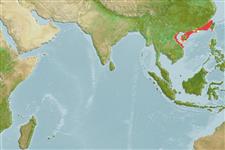Elasmobranchii (tubarões e raias) (sharks and rays) >
Torpediniformes (Electric rays) >
Platyrhinidae (Fanrays)
Etymology: Platyrhina: Greek, platys = flat + Greek, rhinos = nose. It is the same voice used for the Mammalian division made in Primates (Ref. 45335).
More on authors: Bloch & Schneider.
Environment: milieu / Zona climática / intervalo de profundidade / distribution range
Ecologia
marinhas demersal; oceanódromo (Ref. 51243). Subtropical; 25°N - 15°N, 105°E - 120°E (Ref. 114953)
Northwest Pacific: Chinese coast of Taiwan Strait and in the South China Sea to northern Vietnamese waters; not confirmed from Japanese, South Korean or Taiwanese waters (likely to occur in Taiwan).
Tamanho / Peso / Idade
Maturidade: Lm ? range ? - ? cm
Max length : 86.3 cm TL macho/indeterminado; (Ref. 83530); common length : 50.0 cm TL macho/indeterminado; (Ref. 637)
This species is distinguished from its congeners in having the following set of characters: two rows of thorns (strongly hooked and gradually becoming somewhat embedded toward first dorsal fin origin) on mid-dorsum of tail; no thorns at the anterior part of scapular region; thorns on the orbital, nape and scapular regions not encircled by light yellow or white pigment; dorsal surface covered with minute dermal denticles of uniform size and shape, no obvious larger dermal denticles (smooth to touch) (Ref. 86259).
Body shape (shape guide): other.
Found inshore (Ref. 9903), above 60 m on rock or rocky sand bottoms (Ref. 11230). Ovoviviparous (Ref. 50449). Biology little known (Ref. 9903).
Ciclo de vida ou comportamento de acasalamento
Maturidade | Reprodução | Desova | Ovos | Fecundidade | Larvas
Exhibit ovoviparity (aplacental viviparity), with embryos feeding initially on yolk, then receiving additional nourishment from the mother by indirect absorption of uterine fluid enriched with mucus, fat or protein through specialised structures (Ref. 50449).
Compagno, L.J.V. and P.R. Last, 1999. Platyrhinidae. Thornback rays. p. 1431-1432. In K.E. Carpenter and V.H. Niem (eds.) FAO identification guide for fishery purposes. The living marine resources of the Western Central Pacific. Rome, FAO. (Ref. 9903)
Status na Lista Vermelha da UICN (Ref. 130435: Version 2025-1)
Uso pelos humanos
Pescarias: bycatch
Ferramentas
Relatórios especiais
Baixar XML
Fontes da internet
Estimates based on models
Preferred temperature (Ref.
123201): 22.8 - 26.7, mean 25.2 °C (based on 112 cells).
Índice de diversidade filogenética (Ref.
82804): PD
50 = 0.5938 [Uniqueness, from 0.5 = low to 2.0 = high].
Bayesian length-weight: a=0.01000 (0.00244 - 0.04107), b=3.04 (2.81 - 3.27), in cm total length, based on all LWR estimates for this body shape (Ref.
93245).
Nível Trófico (Ref.
69278): 3.5 ±0.37 se; based on food items.
Resiliência (Ref.
120179): Baixo, tempo mínimo de duplicação da população 4,5 - 14 anos (Fec assumed to be <100).
Fishing Vulnerability (Ref.
59153): Moderate to high vulnerability (55 of 100).
🛈
